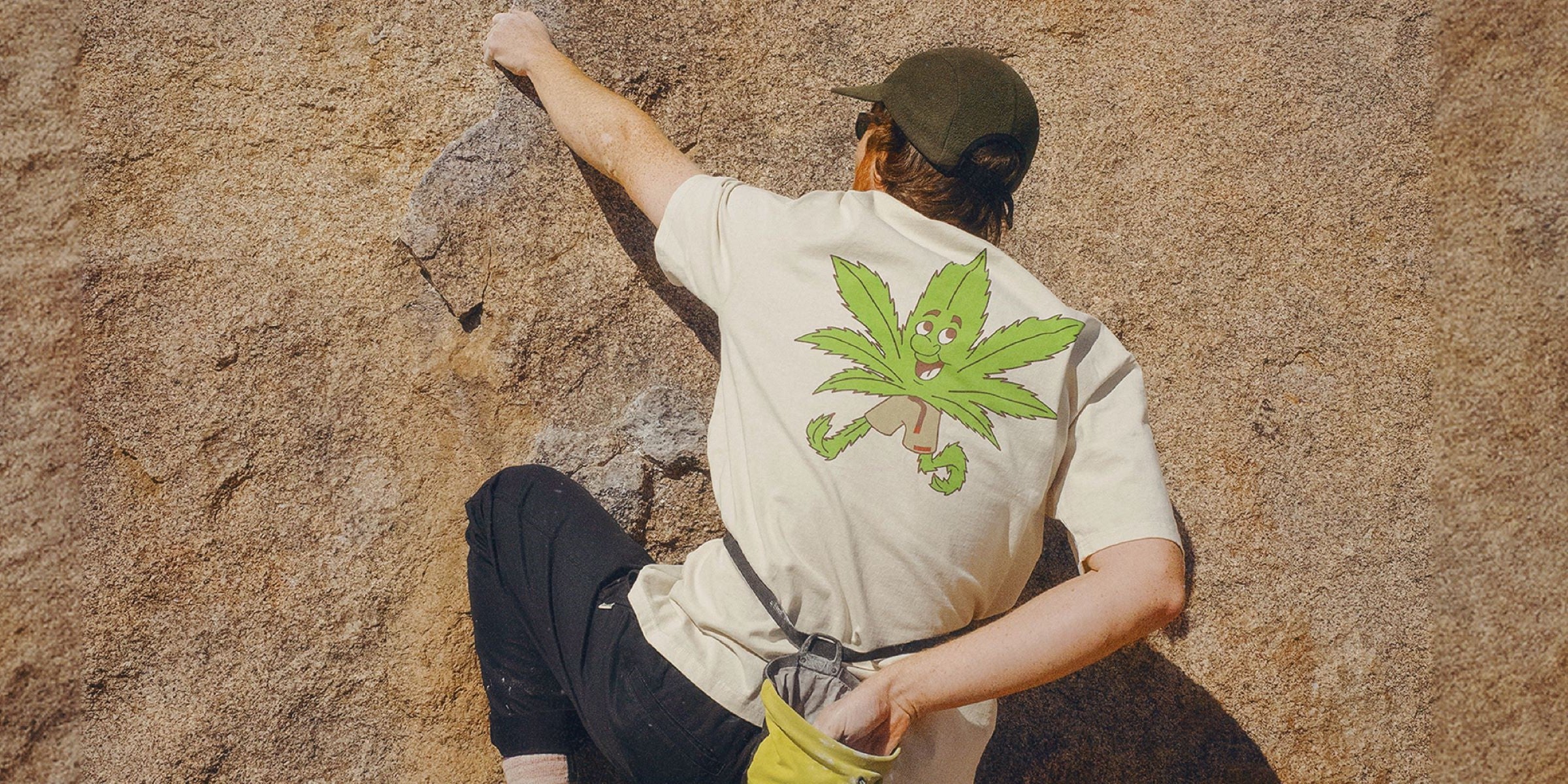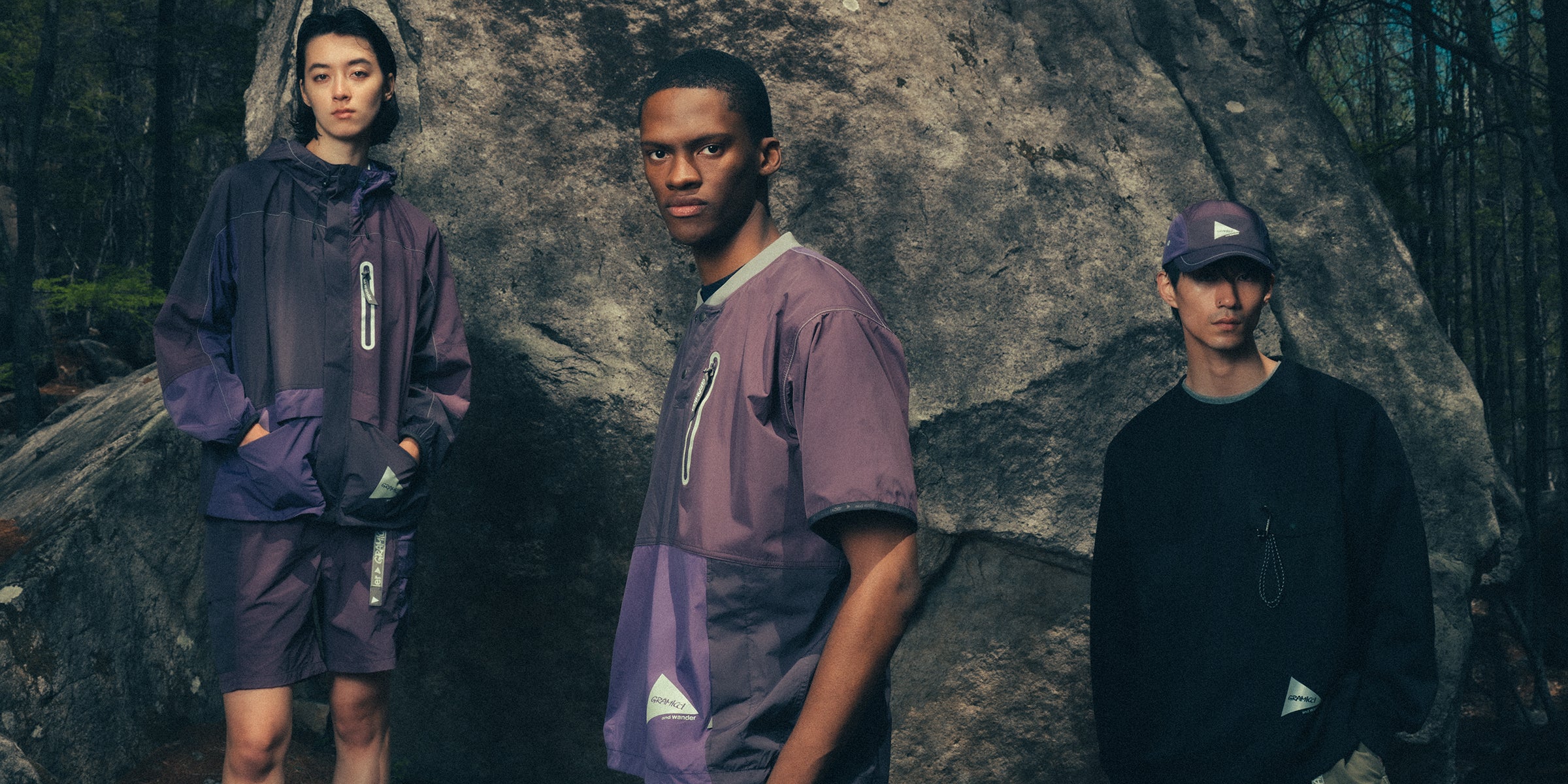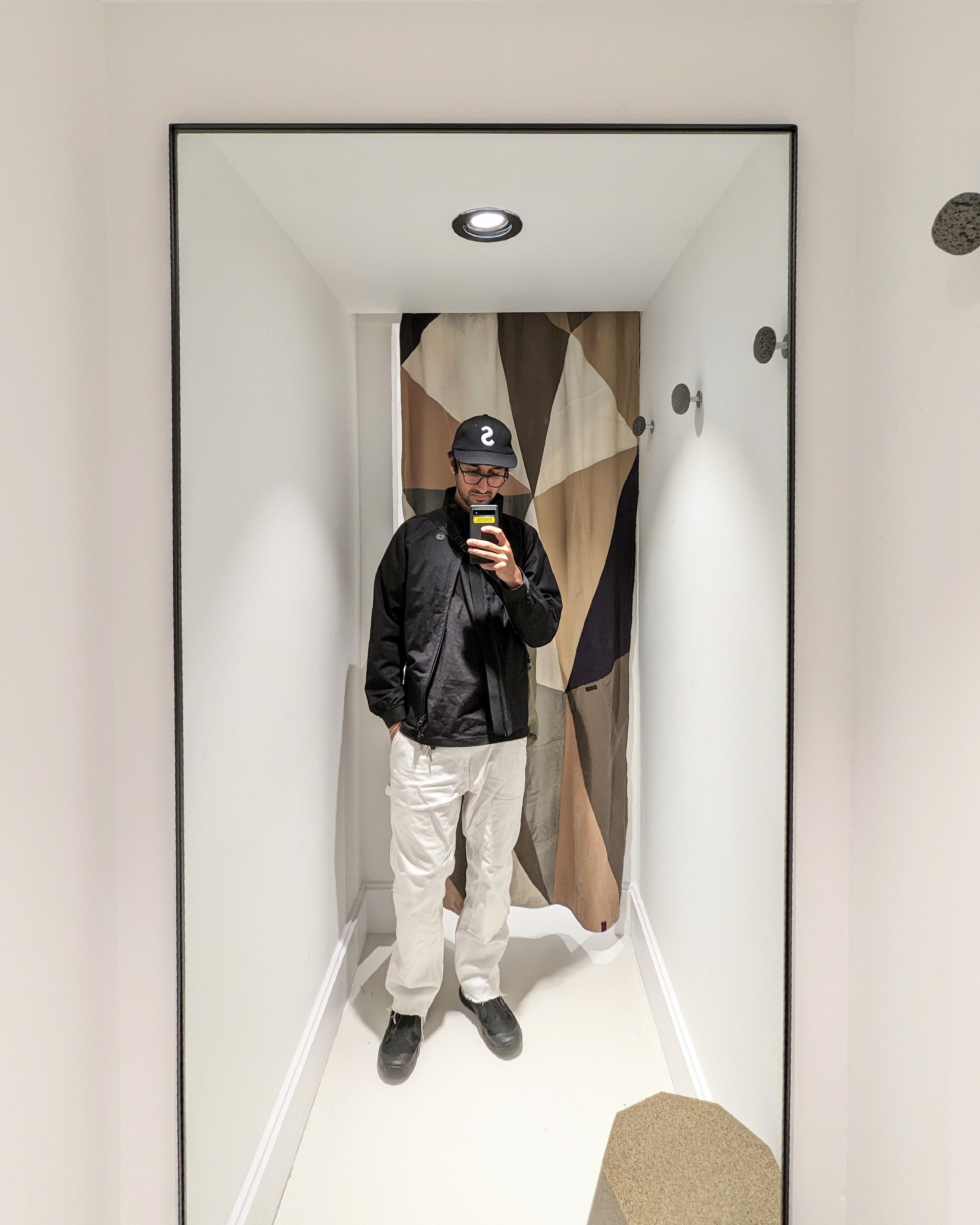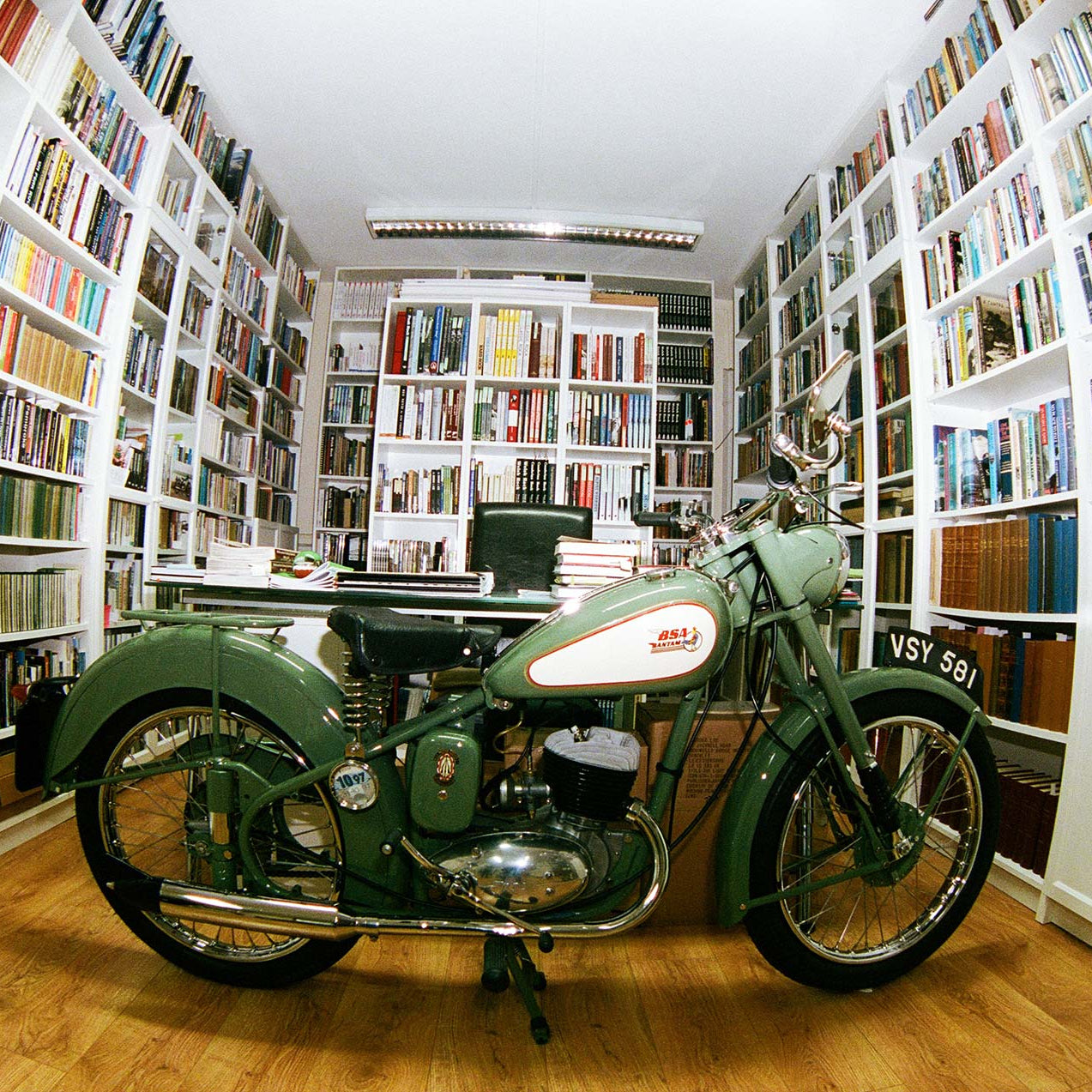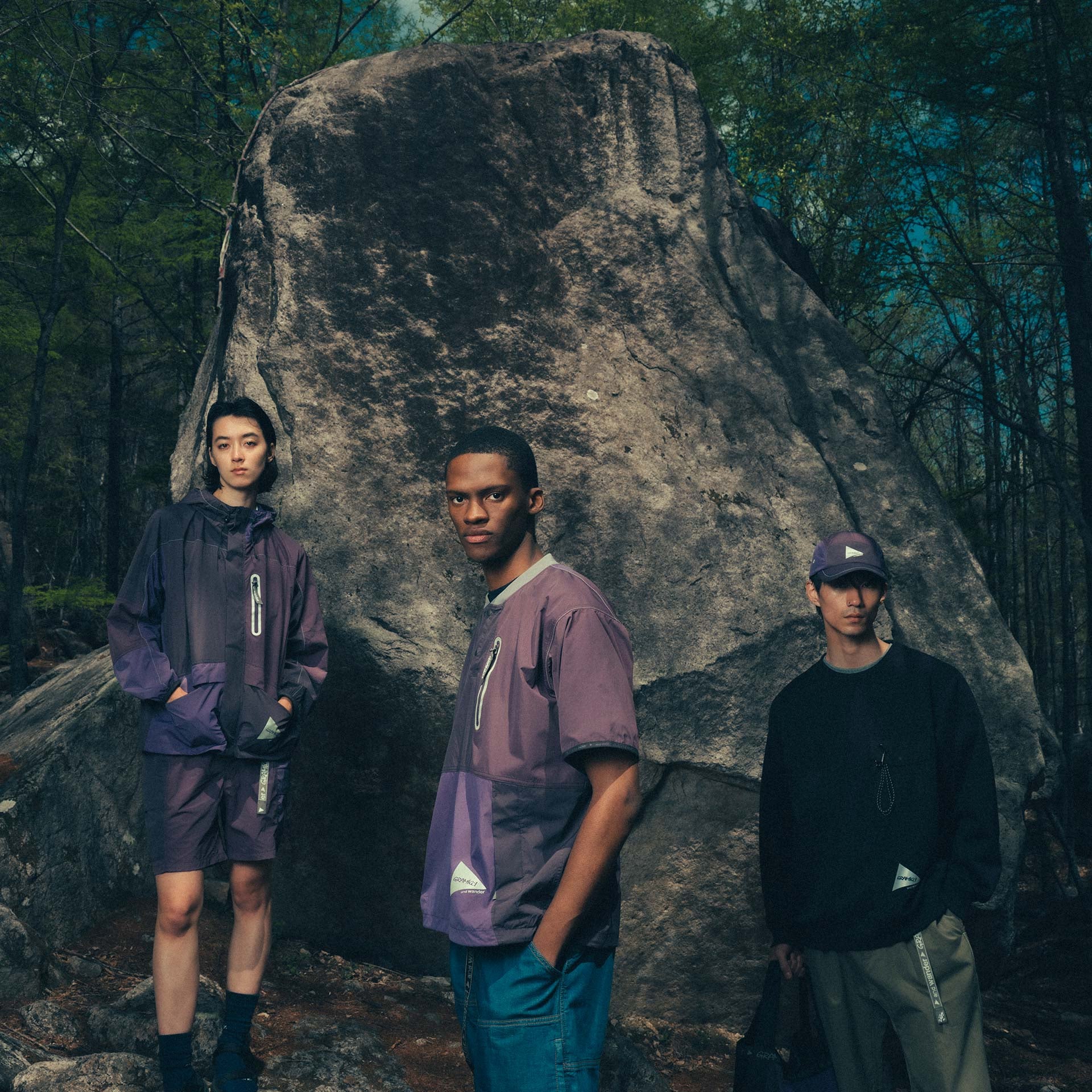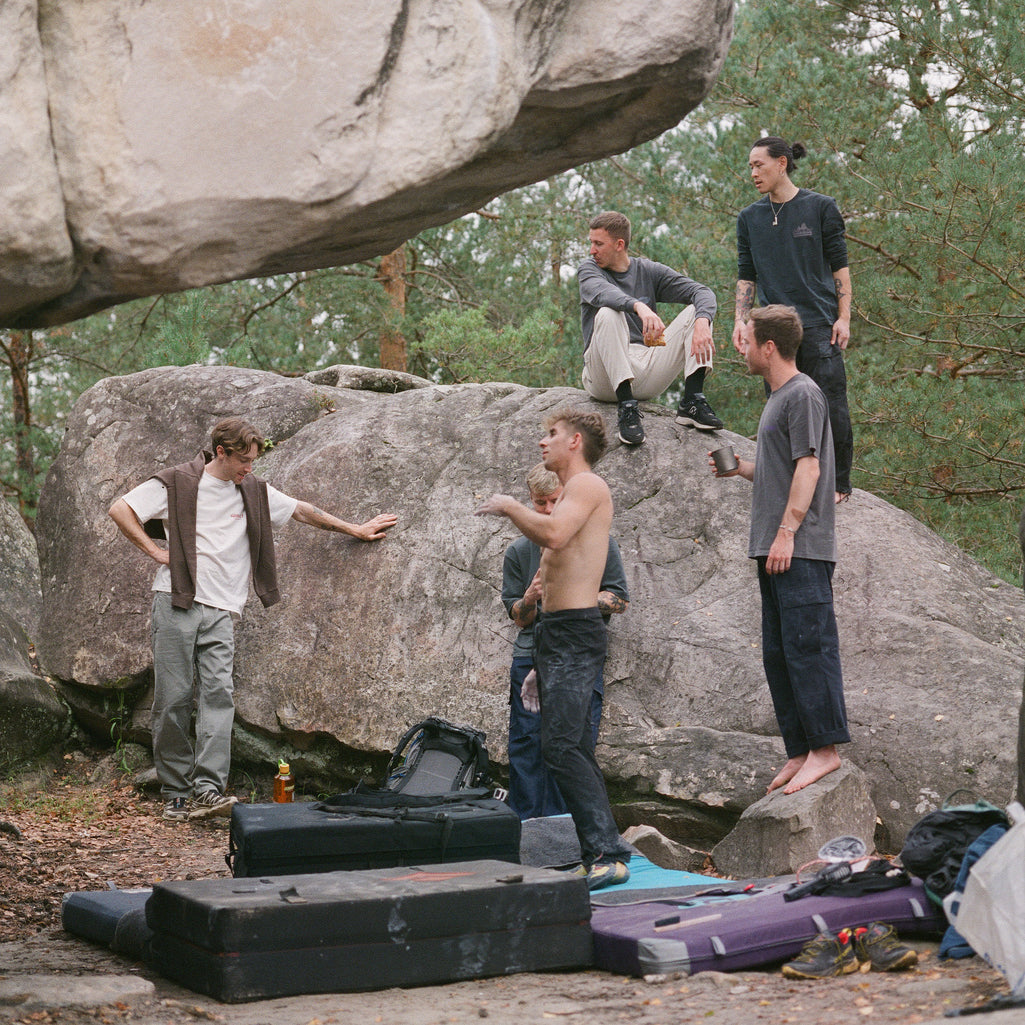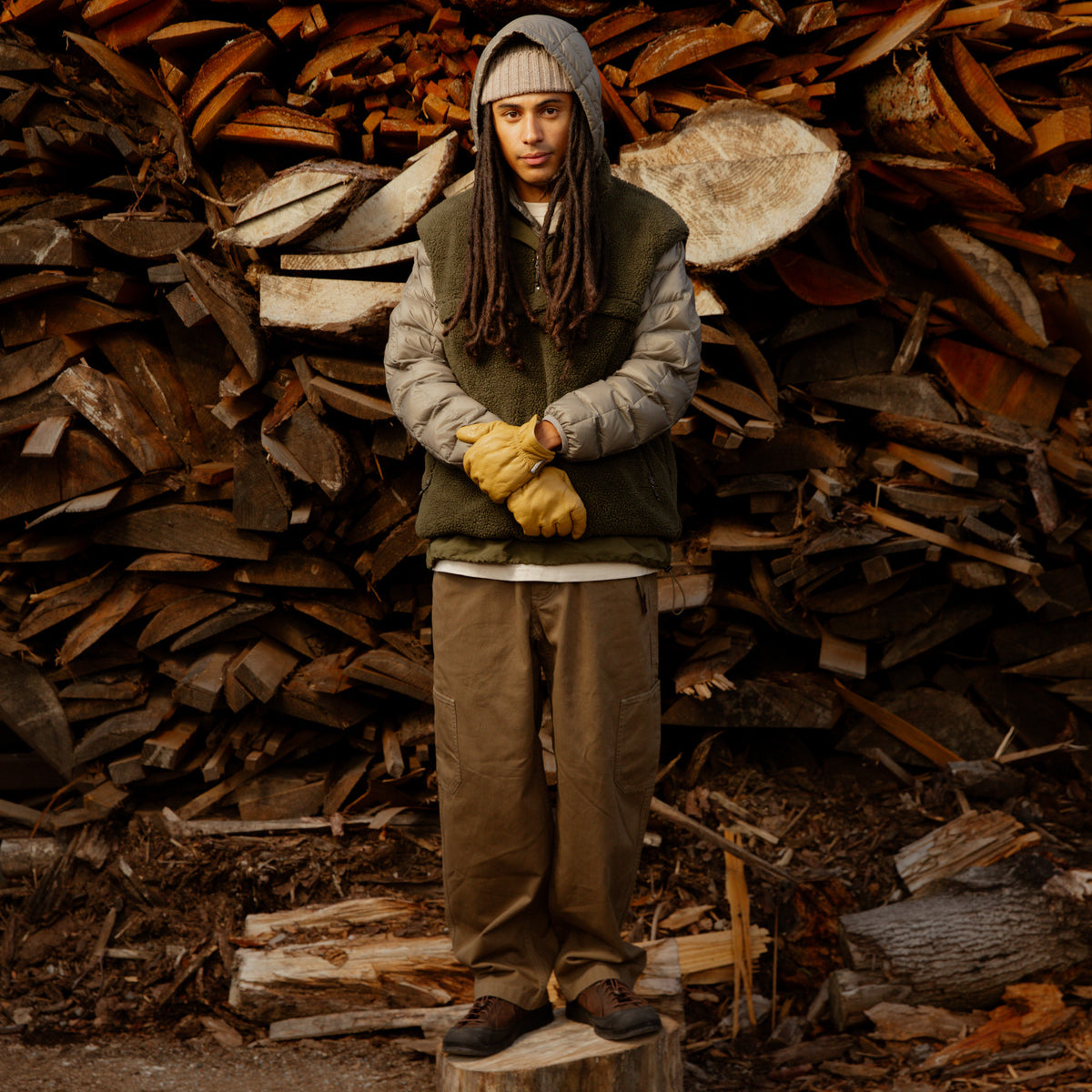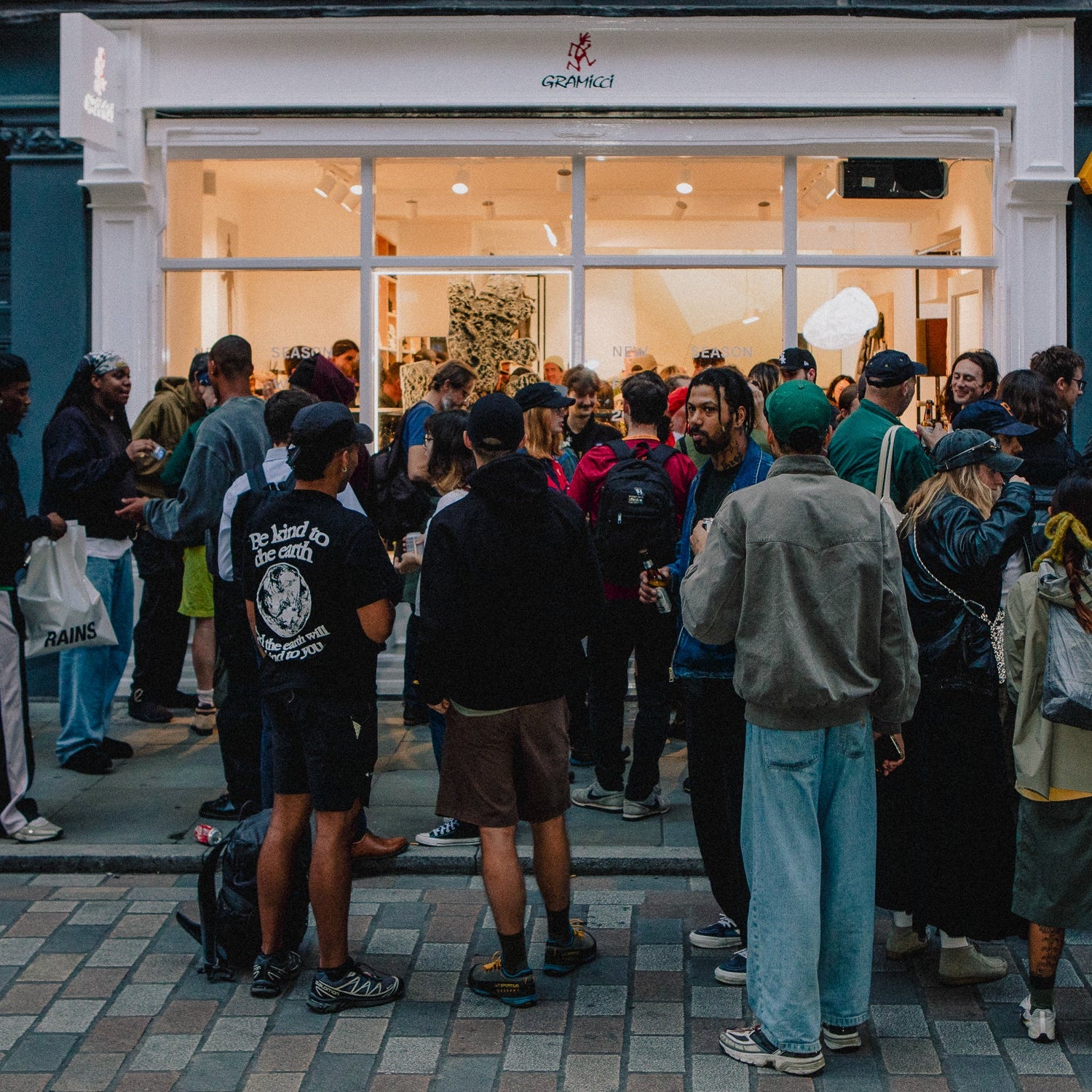If you’ve been in our recently opened London shop, you might have noticed some pretty special curtains in our changing rooms, constructed from none other than old and well-worn trousers from our archives.
These majestic curtains (along with the upholstery on the nearby bench) were made by Greater Goods—a London-based design workshop dedicated to repurposing old gear to make modern, functional items. Their mantra is ‘Nothing into Something’, and that’s a pretty good way to describe what they do. Taking waste fabric and damaged clothing that would otherwise go unused, they create items that aren’t just practical, but look great too—from chalk bags to fully waterproof jackets complete with built-in sausage roll holders.
With his fine handiwork now on display in our shop, we caught up with founder Jaimus Tailor to find out more about Greater Goods, making curtains out of trousers and his obsession with making things…
Going back to the beginning, how did Greater Goods start?
Greater Goods started off with me doing woodwork and carpentry. I was finding bits of wood in my local area—beds people had thrown away, scaffold boards and cedar beams from loft conversions—then I’d take them to my mum’s back garden and make something out of it. I made stools and shelving units—pretty much anything. I was self taught so it was very DIY.
How did you move onto working with clothes?
I was doing the woodworking, but it wasn’t really sustainable to do through the winter months, so I moved to sewing. Whilst I was learning how to sew I was trying to sell a Gore-Tex jacket—and no one wanted to buy it because it was so beat up. But it had a zip and velcro and nice trims—so I thought, “Why not just use this to make something?” And that’s when I realised that from just one piece of outerwear you can get so much. It just snowballed from there—and I became that person who uses outerwear. It just stemmed from a happy accident—it made sense.

So it wasn’t like there was some big master plan then?
No—it was about having fun and making things—using whatever was laying around. It was more from a financial aspect—I wasn’t going to buy brand new fabric for £15 a metre when I could buy a damaged jacket and get a nice zip and all these velcro trims and the lining fabric. You get so much from it.
There’s a lot of hardwear on even just one garment.
Exactly. We found that with the G-Pants we worked with for the Gramicci store. You’ve got all the cotton, and then there’s the webbing belt and the slide-buckle—there are so many nice elements you can use. And it just made sense to work like that from the very beginning. It’s how I was brought up too—it was normal to make things.
It seems like that ‘making things’ thing is important to you. Is it almost something you’ve got to do?
For sure. If I don’t make something, I get a bit distressed. It’s an itch that you can’t get rid of. I had to come in on Saturday to make a bag for myself—I had to make something and get that satisfaction. When we’re busy with projects and I’m on my laptop a lot, I often have to take a day off—but that ‘day off’ is me making something. If I go home and I’m in a stroppy mood my partner will know that I’ve not had a productive day making something.
When I did graphic design before this, I just didn’t find it satisfying. I’d be on my laptop, but when I left the office nothing had really changed—I might have done a lot of work, but nothing new had been made. But with making things in the physical world, you get a huge amount of satisfaction from it.

Maybe it’s seeing the output? There’s a lot of fulfilment in physical work because it’s easy to see what you’ve done at the end of the day.
For sure, it’s just an outlet—and I think it’s different for different people. I have friends who’d hate doing what I do—you have to find what your outlet is. When things are more tangible it stays in your mind better. When I make a product I remember doing every seam. It’s like when you read a book, you absorb the words better than if it was on a screen. It just feels way more human.
Yeah—if you read a book you generally remember where you were and what was going on in your life when you read it. But people don’t really have those same memories attached to reading through Wikipedia or looking at Reddit.
That’s so true. I’ve always been someone who’s resonated with the physical side of things. And also, when I graduated there wasn’t really a job that I could fit into nicely, so I thought I’d try and do my own thing. At the same time I was juggling loads of things trying to stay afloat, but it was just a hobby that evolved over time.
Was there a point when you realised it was more than a hobby?
Probably last week to be honest… nah, I’m kidding. I’d say after the first brand project—we were tiny back then, but we were still approached by this brand to do something, and they still liked what we did. I’d be jumping on Zoom calls in my bedroom to talk to a global brand. They’d ask things like, “Where’s your factory?” And I’d say, “You’re looking at it. I did the pattern cutting on the bed behind me.” I think we were perceived as larger than we were, so we just tried to keep that energy going.

What’s the process of making something? Is it a case of having an idea and working out what archive piece will work for that, or do you start with the vintage piece?
It goes both ways now. At the beginning the product really dictated the outcome. Also, with my skill set then I could only work with what I knew. I was making simple tote bags with no pattern—it was all quite rudimental. Now we’ll propose the outcome from the beginning. So we’ll know we’re making a jacket, and then we’ll look back and think about what we’re making it from.
Despite it being upcycled, we always want our end product to be very functional and very well made—we don’t want it to be a gimmick. It might be quirky, it’s still going to be well made and thought through. We made the sausage roll jacket recently, but it’s a proper wearable piece. It’s a waterproof jacket with DWR treatment. So it’s a fine balance that we work on—and it’s a nice area to exist in.
You’re very DIY, but you’re still making things to a really high quality. You’re given the original piece with respect.
Essentially. We want to do this stuff justice and to make it last. If we’re going to use these pieces, we’re going to use them well—we’re not just going to cut the logo out and use that, we’re going to use everything. We’ve got a full storage space full of zips and webbing.
Working with these clothes you must get such a good knowledge of how they were put together and all their intricate details.
For sure. We love taking apart things—when you cut up a jacket and remove the lining, suddenly you see all the seams. It’s like the layers of onion—you peel it back and see what’s going on. You can learn so much by taking something apart. When we see a nice piece of clothing we like, we’re really looking at every seam and thinking about the final stitch. We’re always trying to find that opening seam. Quite often on jackets we’ll find ski passes in the pocket from Canada or Switzerland—so that jacket’s bounced around the world to end up in our small studio in London.

Before living for another 20 years as a bag.
Yeah, hopefully. We love the narrative of the products we’re using and the journey they’ve been on.
Can you talk us through the Gramicci project? How did you approach making that stuff?
We were chatting with Adam who designed the store layout—he showed us the concept for the space and there was this really nice geometric plywood wall behind the counter, so we wanted to reflect that pattern in the changing room curtain. We made a big pattern with all these triangles, then Adam and the team sent over these damaged G-Pants. They were really heavily used. We sussed out we had just about enough fabric—the curtains were double sided, and the triangles were placed in a way that there’s no colour the same next to each other.
That’s not easy.
It was tricky—especially with the limited fabric we had. And it wasn’t a roll of fabric, it was trouser legs, so we could only use these little triangles—it took a bit of thought. And then once we made the curtains we used the offcuts to make the bench topper—which was inspired by climbing pads, with Cordura on the outside and the G-Pant material on the top. It was super simple, but with nice cues to climbing and the changing room curtain, so it was quite cohesive.
And then once we made those we still had these smaller offcuts so we made some pillows using some stuffing we had left over from a different project. And now finally I’m left with this small box of white offcuts which I’m making a bag out of. So everything has been used.

How many pairs of pants did it take?
I think it was maybe between 10 and 15. And the colour palette was those classic Gramicci colours—like navy, beige and off-white—so it fits the store nicely and really works with the clothing on the rails and the general feel of the space.
Does this signal the start of the Greater Goods homeware division then?
Yep—we’re already doing that now—we’ve got some dog beds coming up. We’ve got a big pinboard of ideas on post-it notes as well as a pinboard of what we’ve got in the studio—and we often match them up to see what we could make. We definitely want to go more into making physical objects outside of just garments and accessories. We’re always trying to push things and see what we can do. I want people to think, “Since when did Greater Goods do that?” whilst still keeping things functional or practical.
That’s a more fun way to be. You don’t have to just do chalk bags, you could do the seats of a Land Rover…
We’re doing that as well! My friend has a Suzuki Carry.
One of those little mini-vans? They’re great.
Yeah that’s the one. It’s amazing. He had it imported from Japan and we’re working on that. We’re open to everything—it’s just making it happen. We’ve got loads of fun projects in the back of our minds. We almost want the old product to be a secondary thought. We want people to see what we make and think, “Oh that’s sick” and then find out it’s made from old product.
When we started this upcycling wasn’t cool. You’d go on Youtube to watch a tutorial and find a 50 year old mum making a pillow with a frilly edge… which is cool—but it doesn’t appeal to a 20 year old. I found there was a massive gap for making sustainability and upcycling normal—as a secondary thing. We should be doing it because it’s right and it makes sense, so we’re always keeping that in our mind—thinking, “How would this be perceived by someone who doesn’t know its upcycled.”
Do you think people’s attitudes to things like upcycling and reworking have changed in the last few years?
I would say yes, but I’m aware that I have a single perspective and I live in a bubble. In the bubble I know I think that people have changed their perspective on things, but on a global scale, I’ve got no idea. We’ve inspired people with our workshops, and I think if we can change one person’s opinion on something and get them into sewing and making, then we’ve done well. But on a larger scale, it’s so hard to tell.
Yeah it’s easy to get a warped perception with how the internet works. I can think something is huge, and then go outside and realise that nobody cares about it.
It’s like when you wear something nice, then when you go to Lidl and no one knows.
Definitely. Although it does feel like younger people are more tuned into fixing their own clothes.
I’d say definitely within that 25-and-younger age bracket it feels like there’s been a shift. I think that’s down to the social platforms and that idea of upcycling becoming a big thing. Now people know that it’s something you can do in your bedroom yourself.

I suppose maybe YouTube has had a big impact on that. Suddenly I can learn how to fix a jacket or repair my car. There’s not that barrier of finding that information anymore.
That’s so true. I learned through YouTube tutorials, and we often still do it. I had to do it the other day when we were trying to work out a pocket design. Access to information now is so easy—if I wanted to repair something I could just Google it and find out how to do it. It’s such a powerful tool, and back in the day it must have been really difficult.
That’s what’s interesting about what you do—technical performance gear isn’t the sort of thing you’d think you could make at home, but you do it all on fairly basic sewing machines. You show it’s attainable.
You can do so much with a simple domestic machine. The machines we use are just standard domestic machines you can get from Argos. When we do workshops people often say that they’ve never given sewing machines a go because they look intimidating, but they’re the simplest machines—you’ve got a foot pedal which changes the pace of the needle, and that’s all it is. I think it’s just breaking that barrier between a product, and how it’s made. We’ve found there’s a huge disconnect there.
Everyone we work with at workshops loves clothing and footwear, but it’s only a small percentage who’ve used a sewing machine or know how things are made. When I learned how to sew suddenly I appreciated things so much more—even a simple piece like a £10 jacket requires time and skill, and I feel like that’s forgotten as there’s so much product.
It’s easy to ignore the craft. Last question as we’ve talked for a while now… what would you say to someone wanting to rev up a sewing machine for the first time?
I’d say just get into it. Try and take something apart and remake it—that’s a good entry level task and you learn so much from it. We still do it now. It’s a never-ending journey. I always say to sell an item of clothing you have and use that money to buy a sewing machine, as you can then make that item you’ve sold five times. Just make something.

